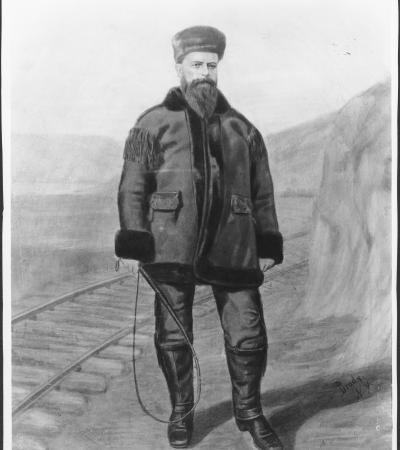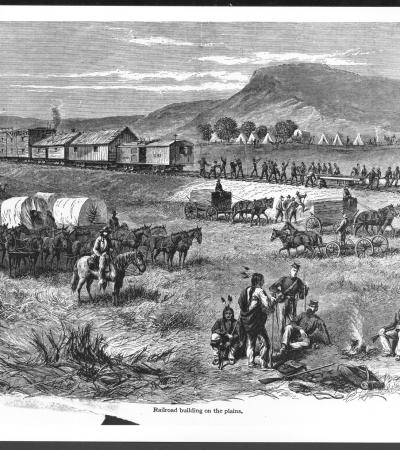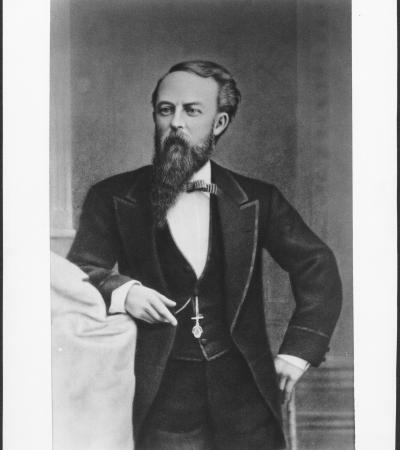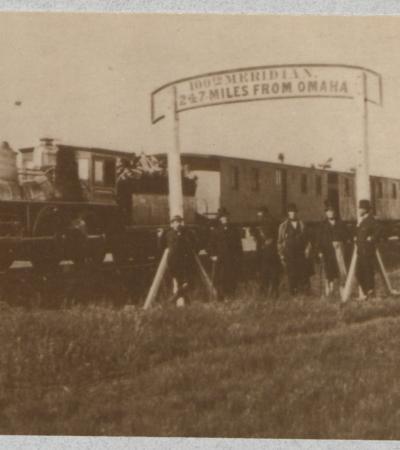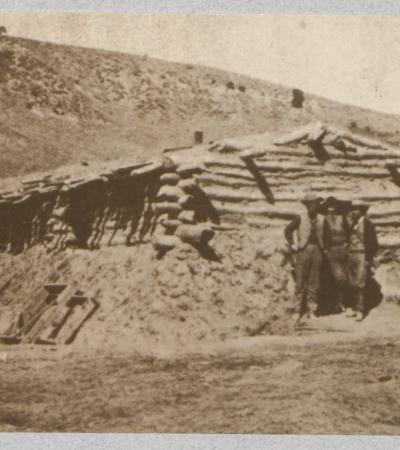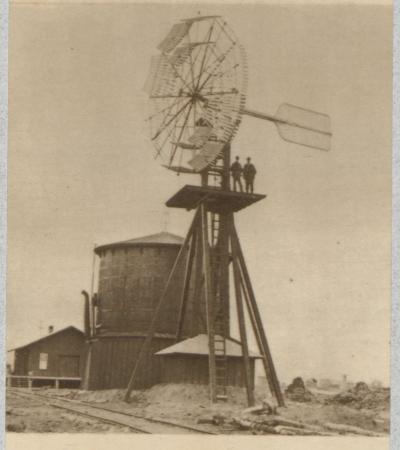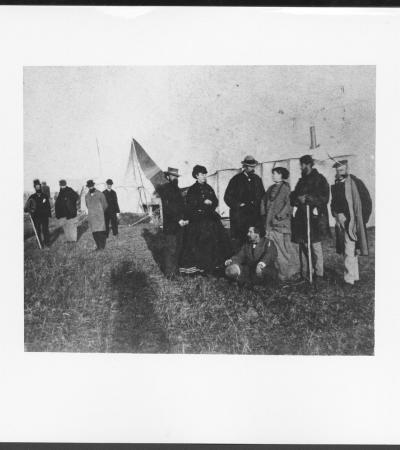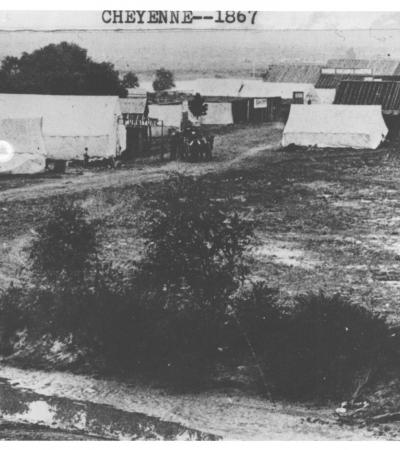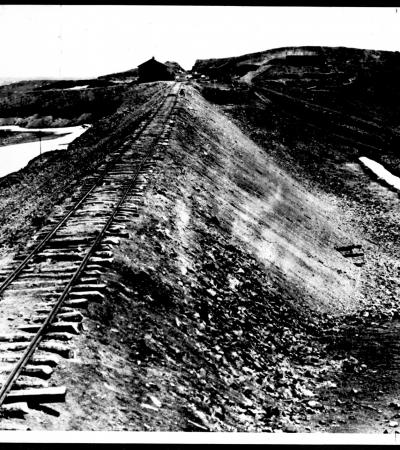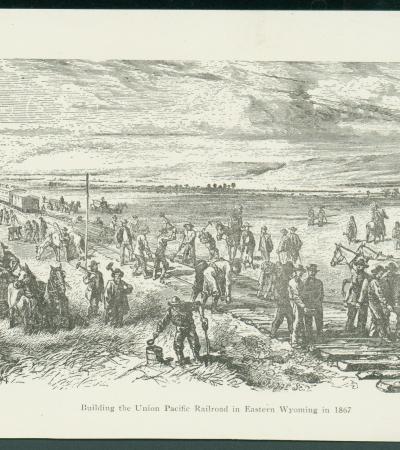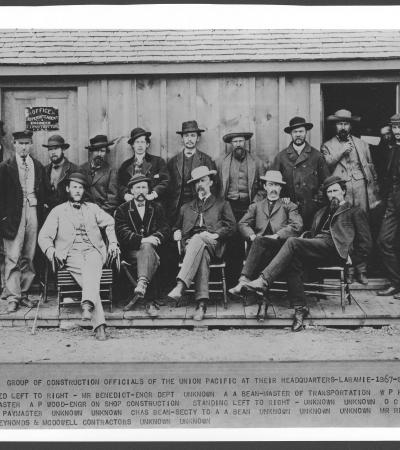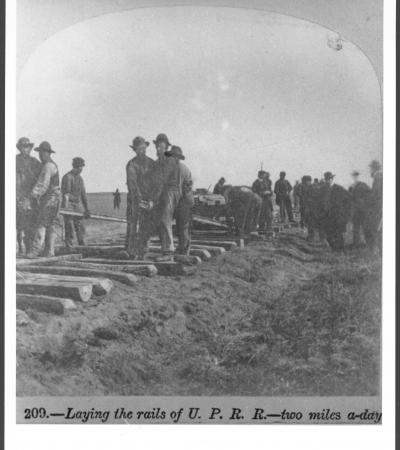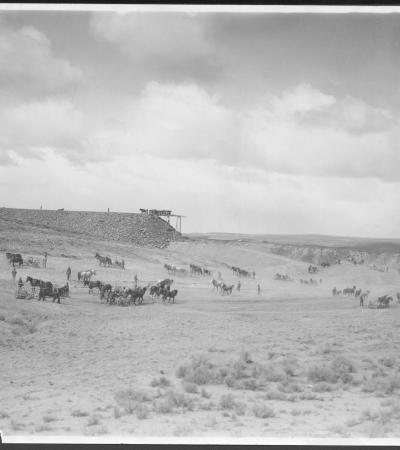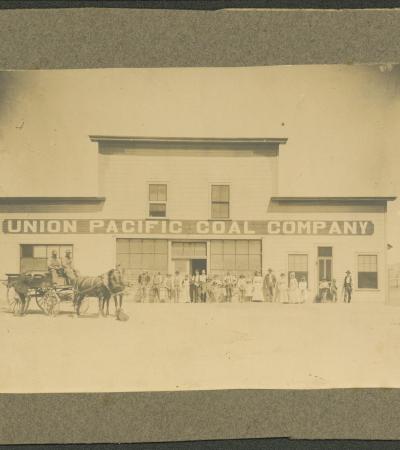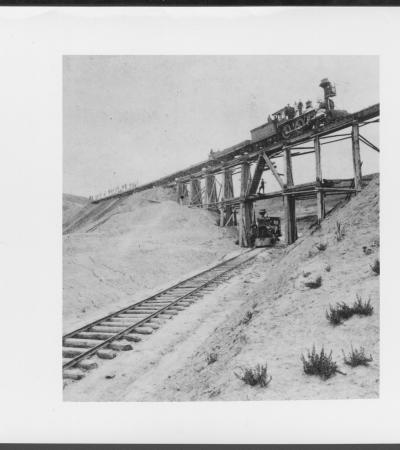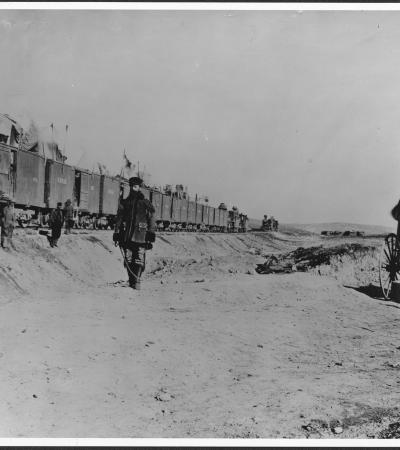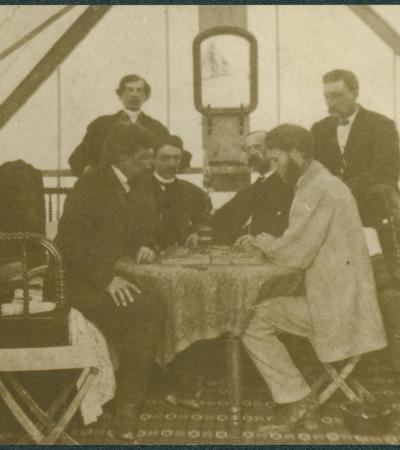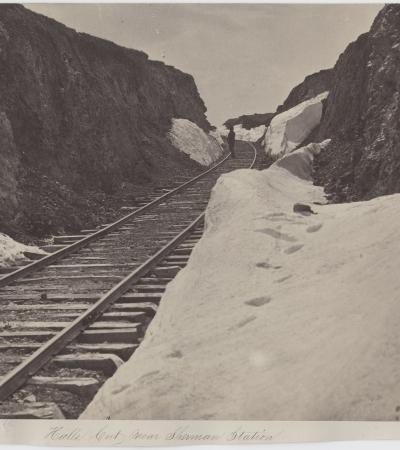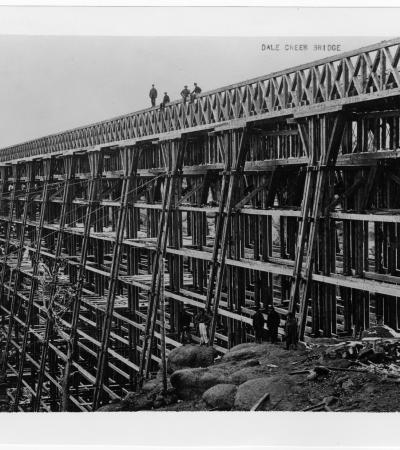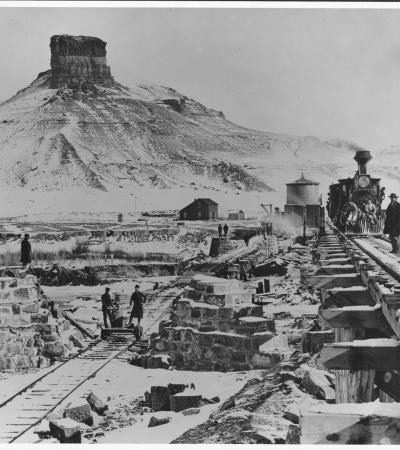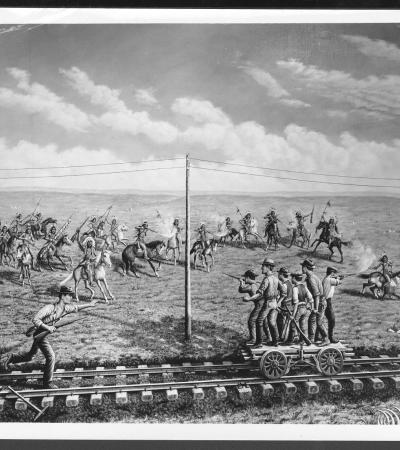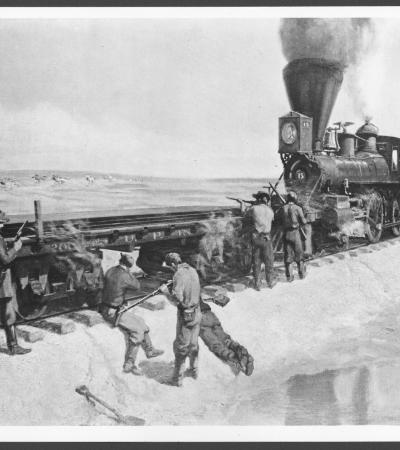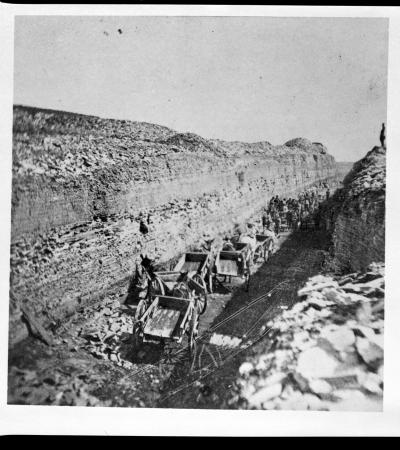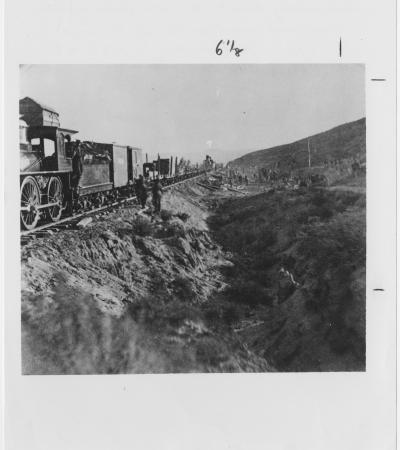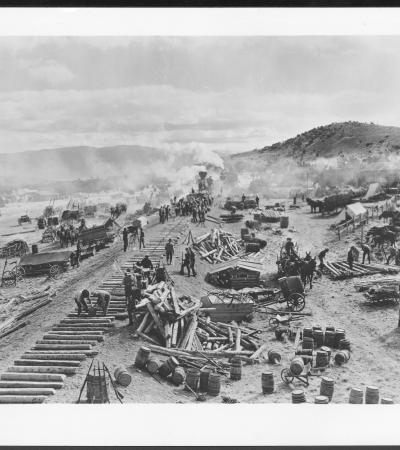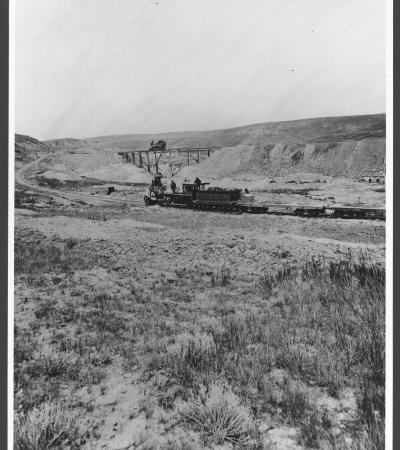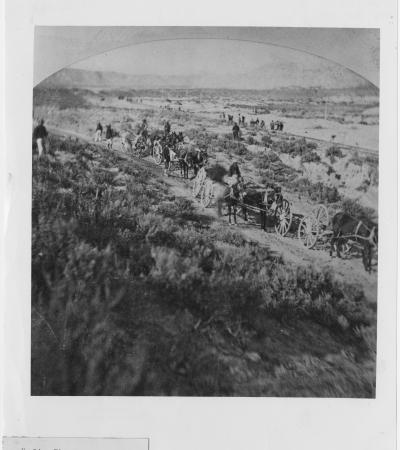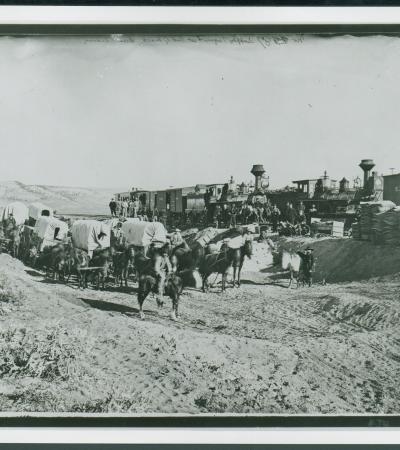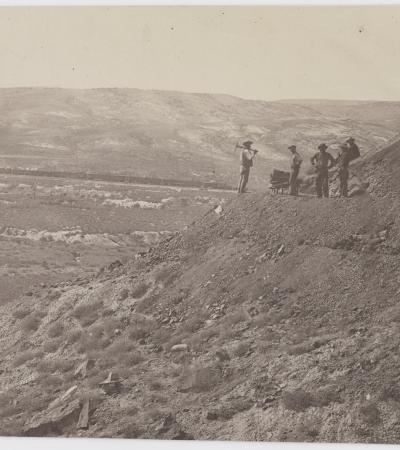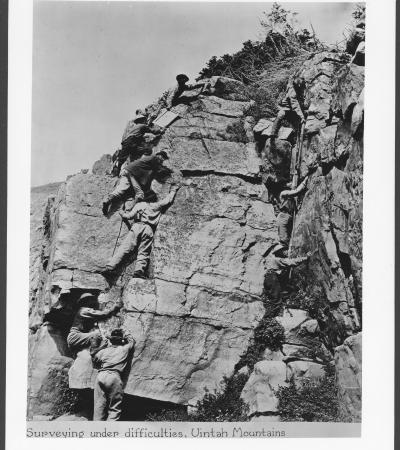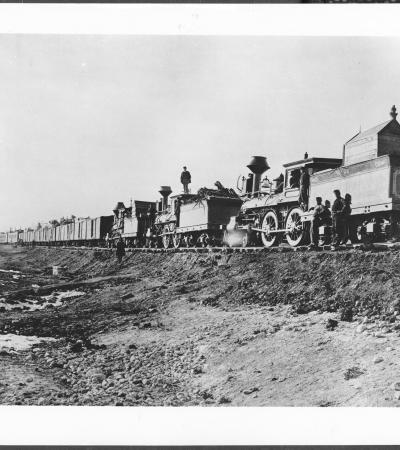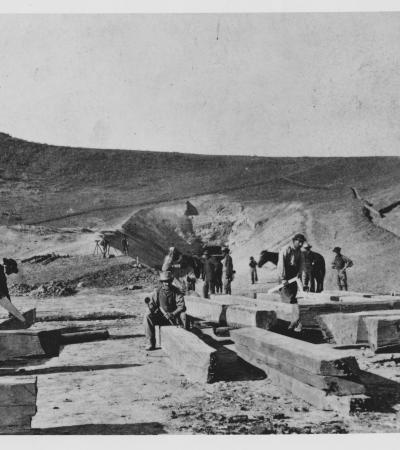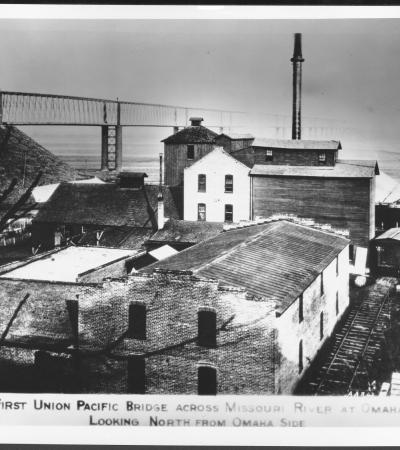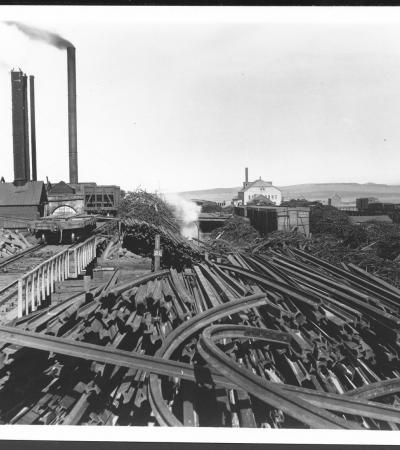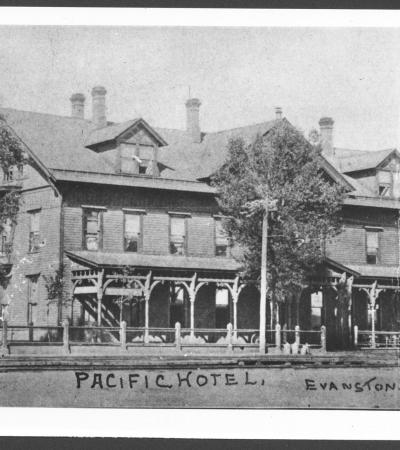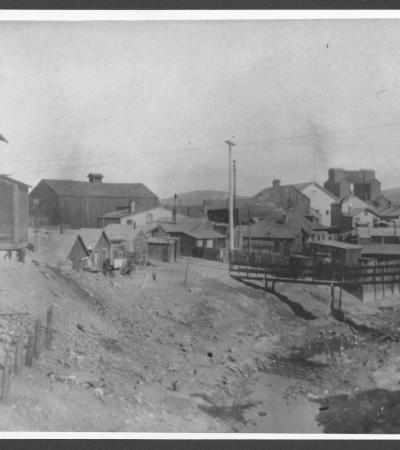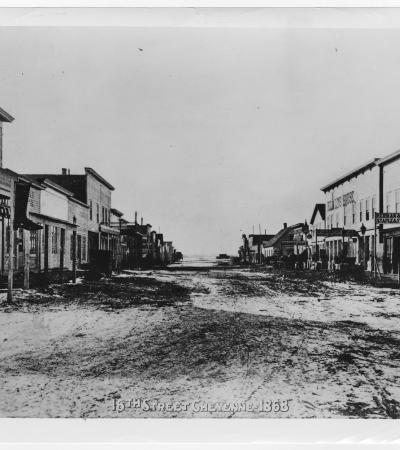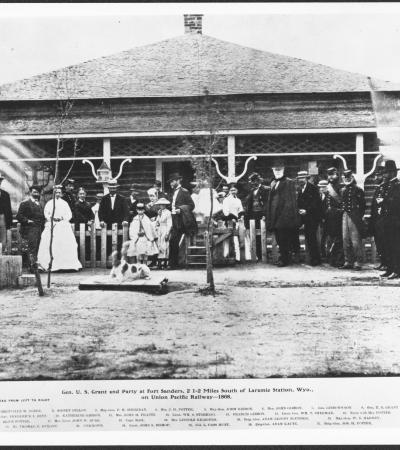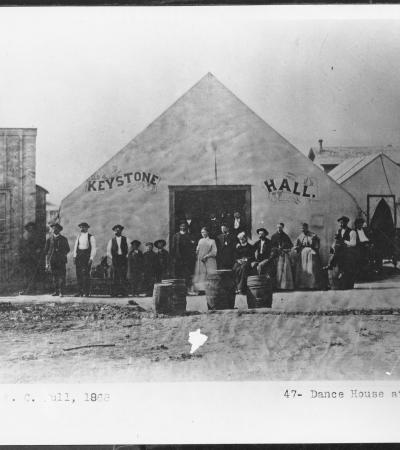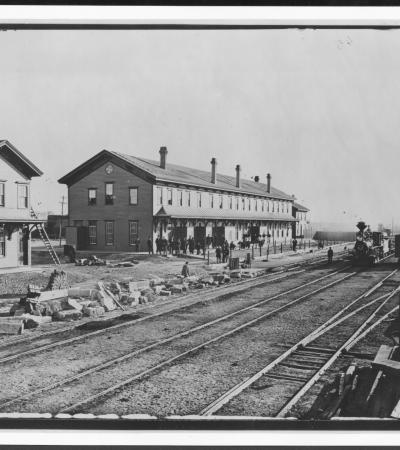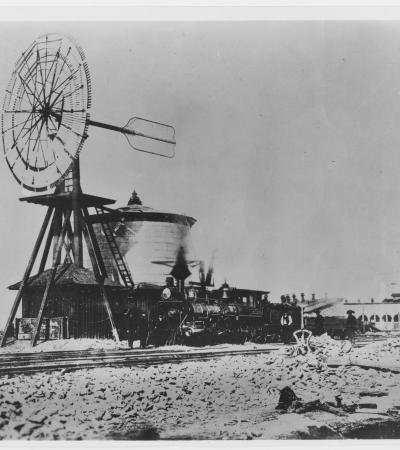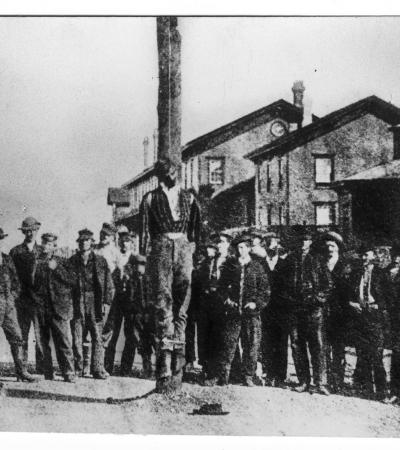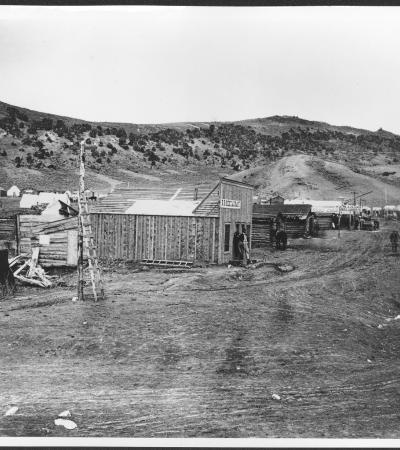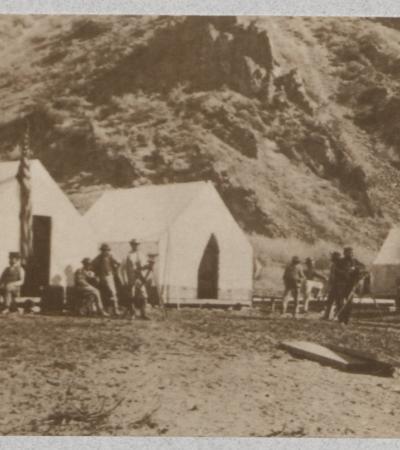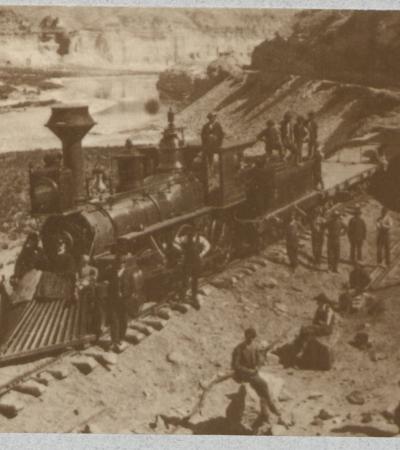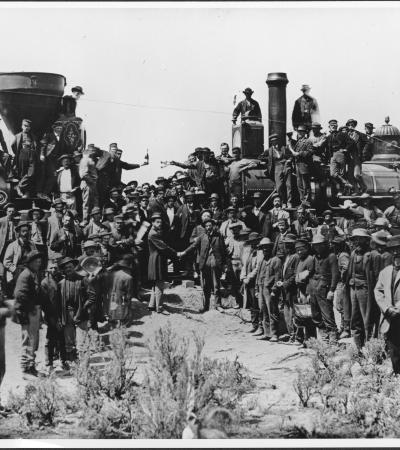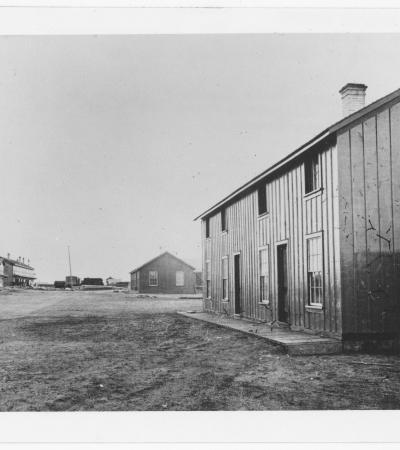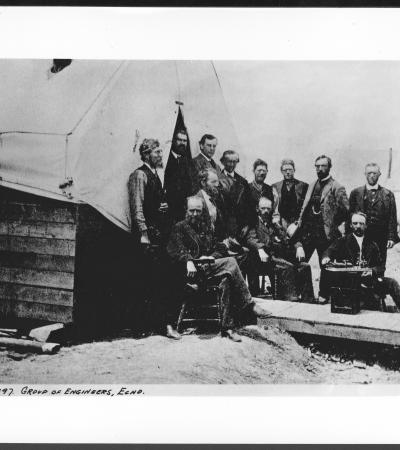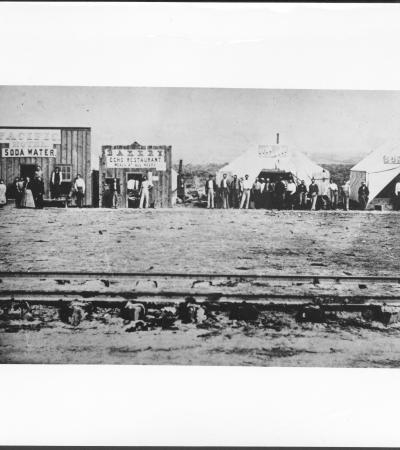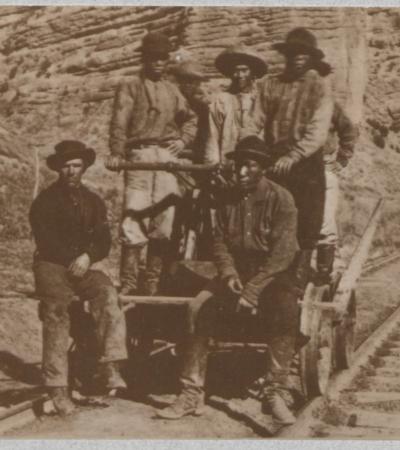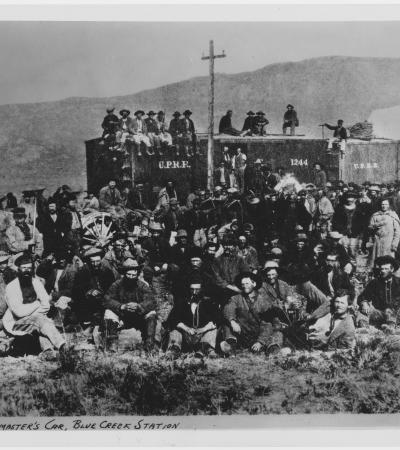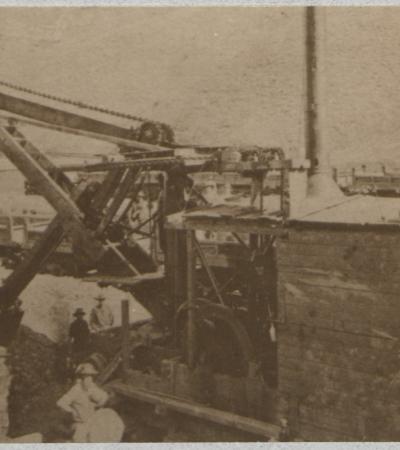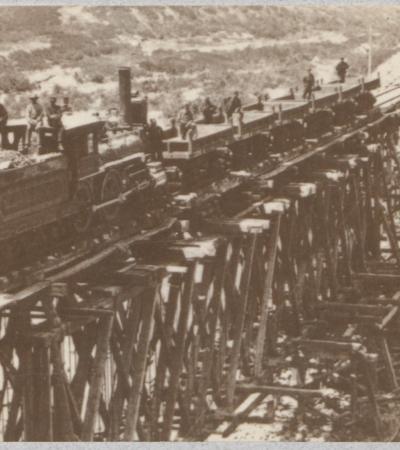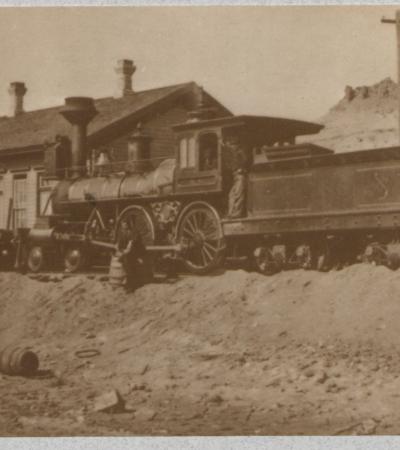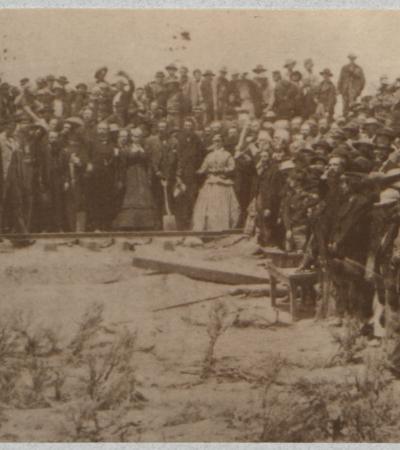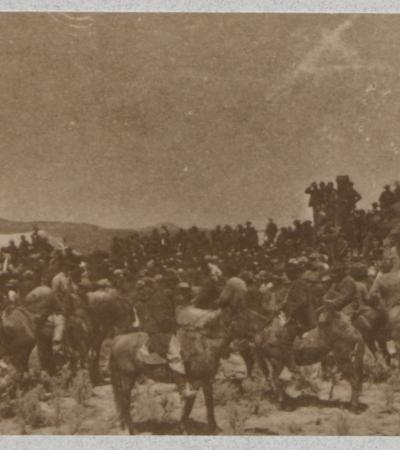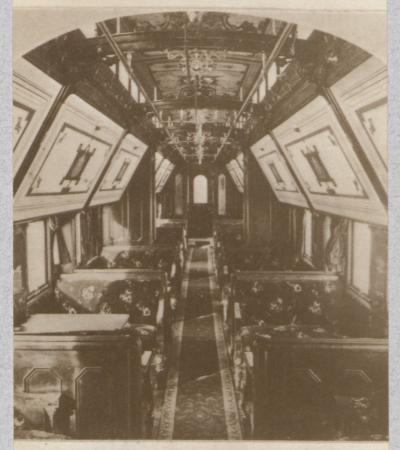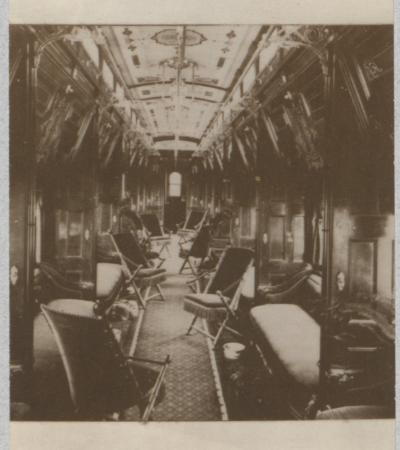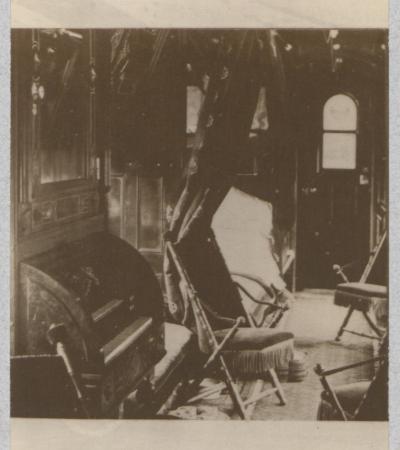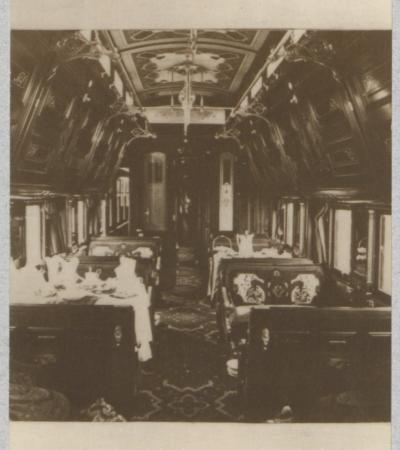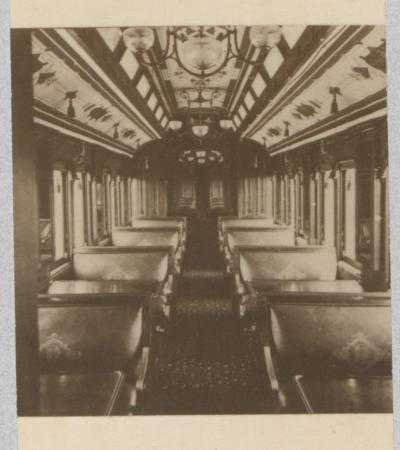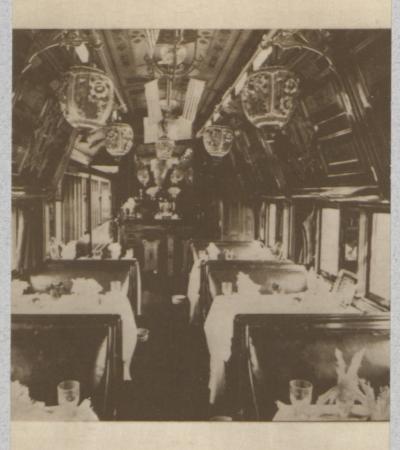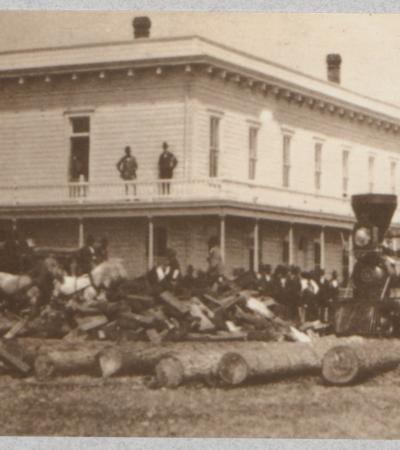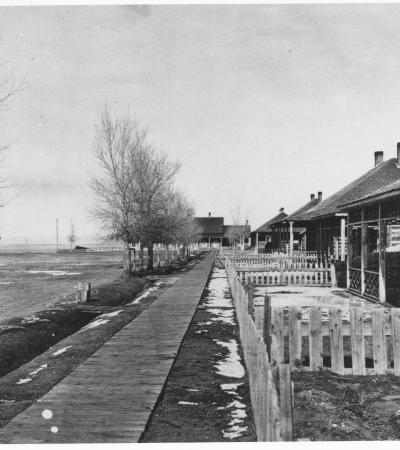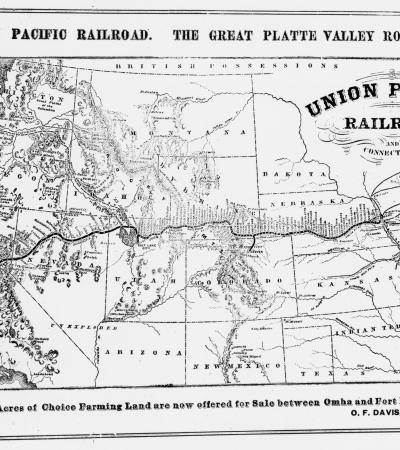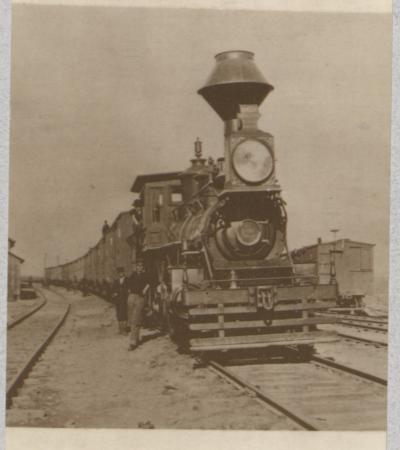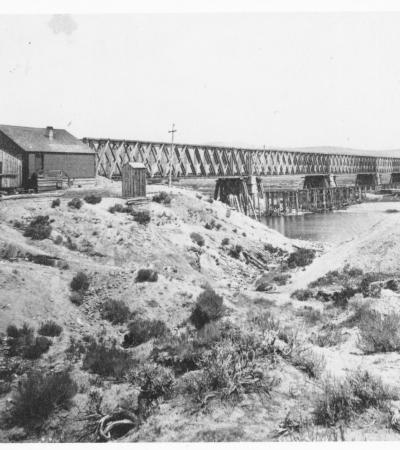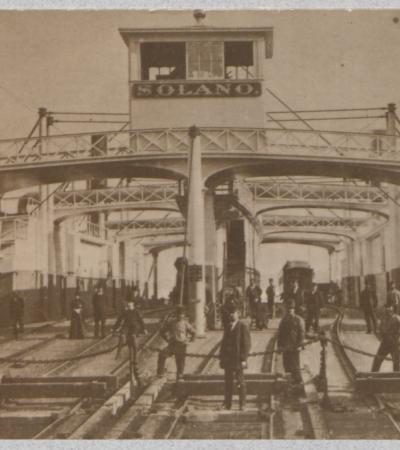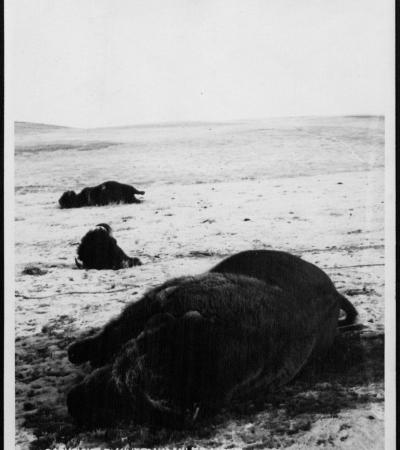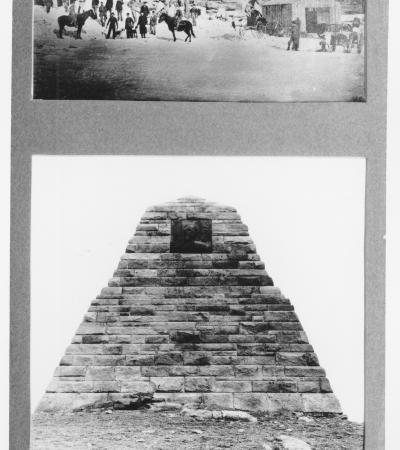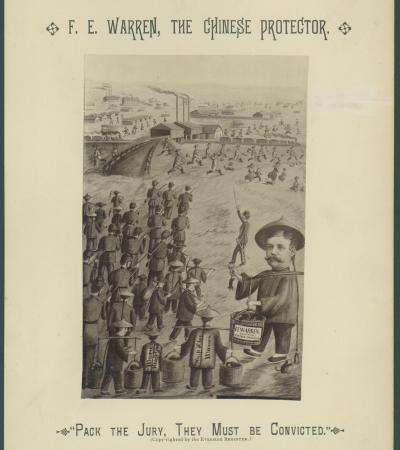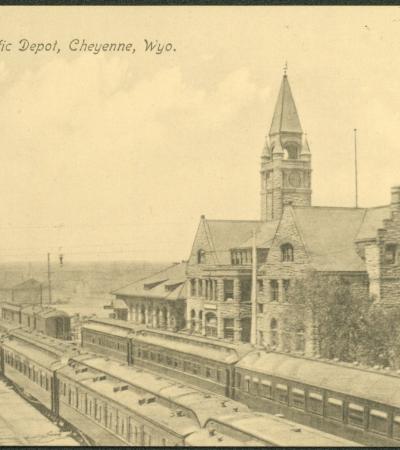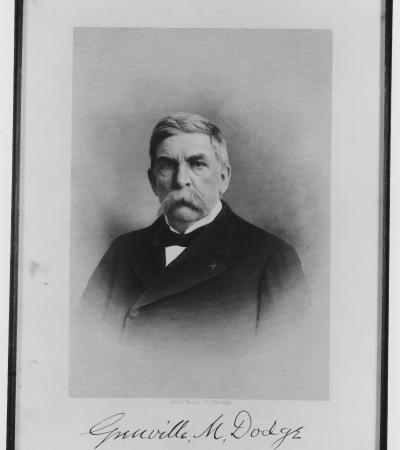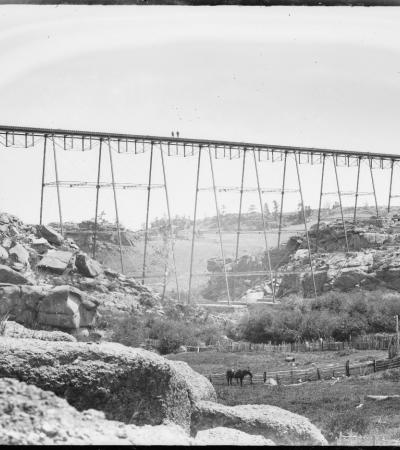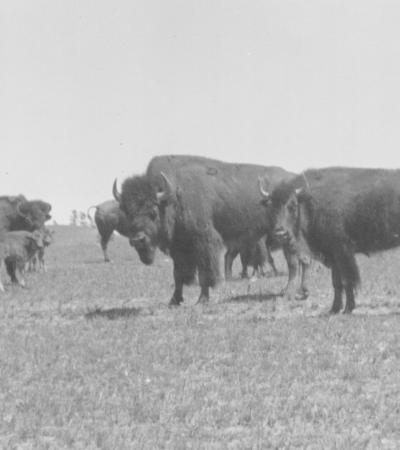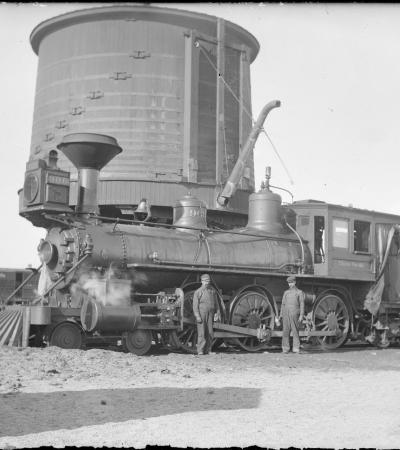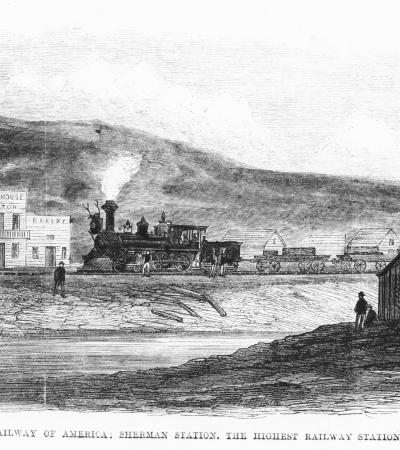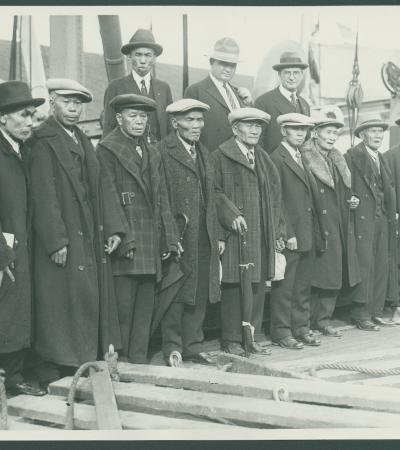This section includes photographs from vertical files and collections related to the Union Pacific Railroad. Most of the items focus on the building of the Union Pacific railway for the transcontinental railroad, but there are some illustrating later impacts of the Union Pacific in Wyoming.
Drawing of John S. "Jack" Casement. Drawing is signed "Brady. N.Y."
In charge of logistics and construction of the UPRR were the actual contractors, the Casement Brothers, Dan and Jack Casement. Jack Casement (1829-1909) served in the Union Army during the Civil War, first in a volunteer Ohio unit and was at the Battle of Winchester. Later he served in Tennessee. At the end of the War, he was breveted as a brigadier general and was, thus, referred to be workers on the railroad as "General Jack."
Sketch titled "Railroad building on the plains."
Grenville Dodge wrote in How We Built the Union Pacific Railway, "To supply one mile of track with material and supplies required about forty cars, as on the plains everything – rails, ties, bridging, fastenings, all railway supplies, fuel for locomotives and trains, and supplies for men and animals on the entire work – had to be transported from the Missouri River. Therefore, as we moved westward, every hundred miles added vastly to our transportation.
Daniel T. Casement
Like his brother and business partner Jack, Colonel Dan Casement (1834-1881) served in the Union Army during the Civil War. Dan was in charge of accounting and payrolls, at times dipping into his own pocket to meet payrolls.
Directors of the Union Pacific Railroad at the 100th Meridian, October 1866
John Carbutt, a prolific publisher and printer of stereo cards in Chicago, briefly preceded A. J. Russell as U.P.’s photographer, but Carbutt’s work was limited in scope. He was hired to document a promotional event celebrating U.P.’s progress: the October 1866 Union Pacific Excursion to the 100th Meridian. It was Carbutt’s job to create souvenir stereo cards for the railroad boosters, funders, politicians, and journalists invited on a special train.
Central Pacific Railroad construction crews' dining room at the end of Tunnel No. 2, ca. 1866
Tunnel No. 2 located just east of Emigrant Gap and 84 miles from Sacramento, California, was completed by Central Pacific Railroad crews in September 1866. Photograph taken by Capt. A. J. Russell.
Windmill and water tank along Union Pacific Railroad tracks, Columbus, Nebraska, ca. 1866
The scarcity of good water, free of alkali, along the railroad made it necessary to dig deep artesian wells for boiler water. Columbus, Nebraska, was promoted by George Francis Train as a new U.S. capitol due to its geographic center in the nation. Photograph by Capt. A. J. Russell.
Union Pacific excursion to the 100th Meridian, 1866. Photograph by photography pioneer and Union Pacific's official photographer John Carbutt.
Caption on the back: "Photographed at Platte City Headquarters October 25, 1866. Seated is George Francis Train and behind him are Mrs. Train and T.C. Durant. Excursion to the 100th Meridian." When Casement and his crews passed this point, it guaranteed the Union Pacific the irrevocable right to continue westward, as stipulated in the Pacific Railroad Act. Thomas Durant, the vice president and general manager of Union Pacific, hosted a "100th Meridian Excursion" with a group of politicians, reporters, and other notable figures.
Cheyenne, Dakota Territory, 1867
The Union Pacific platted its "Crow Creek Crossing" townsite on July 5, 1967. By August 8, 1867, the town of Cheyenne was incorporated. The tracks reached the new town by November 13, 1867.
Copy of the photograph "Granite Canon, from the Water Tank" by Andrew J. Russell, 1867.
On Dec. 2, 1863, construction began on the railroad in Omaha, Nebraska Territory, but only made 40 miles by the end of 1865. The following year the line made it 260 miles, stopping at North Platte, Nebraska Territory, for the winter. In 1867 the road made it another 240 miles before stopping at Granite Canyon on the slopes of the Laramie Range west of Cheyenne.
"Building the Union Pacific, Nebraska." Woodcut from sketch by Alfred R. Waud, 1867
During this time illustrations for magazines and newspapers were done by illustrators. There was no way to transfer a photograph to a printing plate at this time. The halftone process had not yet been invented. An artist such as Waud would do detailed sketches in the field, which were then sent by courier back to the main office of the newspaper or magazine they were working for. A staff of engravers would use the sketches to create engravings on blocks of boxwood.
Union Pacific construction officials at the office of the Superintendent & Engineer of Construction, Laramie City, Dakota Territory, 1867
A caption on the photograph identifies some of the men in the photograph. "Seated left to right - Mr Benedict - Engr Dept, Unknown, A A. Bean - Master of Transportation, W P Kennedy- Paymaster, A P Wood - Engr on Shop Construction. Standing left to right - Unknown, Unknown, O C Smith - Asst Paymaster, Unknown, Unknown, Chas [Charles] Bean - Secty to A A Bean, Unknown, Unknown, Unknown, Mr Reynolds oF Reynolds & McDowell Contractors, Unknown, Unknown."
Photo captioned, "Laying the rails of U.P.R.R.--Two miles a day." Photograph by Union Pacific Railroad's official photographer John Carbutt.
Building the transcontinental railroad transformed the art of laying rails into something of an exact science. In time both roads were laying two, three, and even four miles day after day. For its part, the Union Pacific was resting on its laurels, having some months earlier staged a marathon from daybreak into the night that yielded an amazing seven-and-three-quarter miles.
Bridge building along Union Pacific Railroad.
The railroad companies first built temporary wooden trestles and bridges that they later replaced with more durable and permanent iron structures. Wood, though prone to decay and fire, was cheaper and more obtainable than the iron (and, much later, concrete) that would replace it.
Union Pacific Coal Company building in Carbon, Wyoming.
Photo caption on the back, "Papa's store in Carbon, Wyoming." Now a ghost town, Carbon was founded in 1868 on Union Pacific Railroad line. The town was named for its coal mines. It was located halfway between Laramie and Rawlins.
Echo Canyon Bridge
Before the advent of the railroad, trusses were used in foot and wagon bridges. The design was made up of supporting members joined together into triangular forms. For the railroad, the truss bridge was reinvented and constantly improved upon, from its overall design to the design of its separate members. The truss was ideal for the transcontinental railroad because it required less lumber. Its downward thrust required fewer substantial support members than the horizontal thrust of an arch bridge would have needed.
Copy of the photograph "General John S. Casement and His Outfit" by Andrew J. Russell, 1867-1868
Although barely five feet tall, Jack Casement was tough as nails worked his men hard. He carried a bullwhip to intimidate tracklayers. The crews lived in 20 cars, including dormitories and an arsenal car containing a thousand loaded rifles. The photographer of the image was Andrew Joseph Russell. He was employed during the Civil War by famed war photographer Mathew Brady. Following the war, Russell served the federal government on some of the surveying expeditions in the West before being employed by the Union Pacific.
Game of checkers in UPRR paymaster's tent, Laramie, 1868. Photograph by Andrew J. Russell.
This is a postcard that was made from a much older photograph. Printed on the back of the postcard: "The interior of the Paymaster's Tent at Laramie City. The slow emulsions available to the photographer, Capt. Russell, made this a most difficult shot." "Capt. Russell would have been Andrew J. Russell.
Copy of the photograph "Hall's Cut" by Andrew J. Russell, 1868
To make the shortest route to the top, Union Pacific engineers established a 90-foot grade that climbed 32 miles from the base of the Black Hills. The peak was first called Lone Tree Pass and later renamed Sherman Summit in honor of General William Tecumseh Sherman. Though General Dodge was often named as the one who discovered the pass, credit is more often given to English-born engineer James Evans, who surveyed the area in 1864. Sherman, was the highest point on the transcontinental railroad.
Copy of the photograph "Dale Creek Bridge," by Andrew J. Russell, 1868."
The wooden bridge swayed in the wind as the first train crossed it on April 23, 1868. Carpenters rushed to shore it up. In the mad dash, two fell to their deaths. The bridge continued to flex under the strain of passing trains.
Citadel Rock and Green River Bridge, 1868. Photograph by A. J. (Andrew Joseph) Russell.
The Green River was crossed with a new bridge, and the new "railroad" town of Green River constructed there after the tracks reached the Green River on October 1, 1868—the last big river to cross.
Drawing of an attack by Native Americans on U.P.R.R. construction crew, 1868
The Union Pacific faced resistance from Native American tribes who were seeing treaties broken and their homelands invaded and irrevocably changed. The railroad workers were armed and oftentimes protected by U.S. Calvary and friendly Pawnee Indians, but the workforce routinely faced Native American raiding parties that attacked surveyors and workers, stole livestock and equipment, and pulled up track and derailed locomotives.
Drawing of an attack by Native Americans on U.P.R.R. construction crew, 1868
Captioned on the back, "Drawing of the Indian attack on U.P.R.R. construction as road approached Laramie City, 1868."
Union Pacific Railroad construction using horse carts, 1868 - 1869.
Horses and mules were of primary importance as the movers of rail and dirt. The railroad also used animal power to drive wooden bridge piles.
Unloading ties and iron, 1868 - 1869
Rails, which weighed the most, were often kicked off the flatcars and carried by gangs of men on each side of the rail to where they were needed. The rails just in front of the rail car would be placed first, measured for the correct gauge with gauge sticks, and then nailed down on the ties with spike mauls. The fishplates connecting the ends of the rails would be bolted on and then the car pushed by hand to the end of the rail and rail installation repeated.
Union Pacific Railroad construction, 1868 - 1869
Union Pacific's Chief Engineer Grenville Dodge wrote in his book How We Built the Union Pacific Railway, "Central Wyoming was desolate, dreary, not susceptible to cultivation and only portions of it fit for grazing." In winter, the cold was beyond belief. In warmer months, it was unimaginably hot. In the desert, the ambient temperature was around 110 degrees, while the temperature inside an engine cab topped out at 150 to 160 degrees.
Union Pacific Railroad work trains, 1868 - 1869
As the road extended westward, canyons full of cedar trees near North Platte fell to the ax, and workers crafted hewn ties in the mountain forests of Wyoming.
Hauling railroad ties, 1868 - 1869
Supply trains carried all the necessary material for the construction up to the railhead, with mule or horse-drawn wagons carrying it the rest of the way if required. Ties were typically unloaded from horse-drawn or mule-drawn wagons and then placed on the track ballast and levelled to get ready for the rails.
Copy of the photograph "Supply Trains" by Andrew J. Russell, 1868 - 1869
Caption on the back of the photo: "Supply trains at End of Track, Last Siding. A Casement work train unloads materials to be carried forward by freight wagons to Union Pacific track crews racing toward Promontory Summit."
Copy of the photograph "Bitter Creek Valley" by Andrew J. Russell, 1868 - 1869
Same composition of another A. J. Russell photograph titled "View near Point of Rocks."
Copy of the photograph "Surveying under difficulties" by Andrew J. Russell, 1868 - 1869
Surveyors, using specialized equipment, were tasked with finding the best route for both the Union Pacific and Central Pacific Railroads.
Copy of A. J. Russell's photograph "Gen. Casement's Construction Train," 1868-1869
In the final push of the railroad, Casement's train grew in length to 80 cars, including payroll and telegraph car, bunk cars, and a butcher car which supplied fresh beef to workers from a herd driven along the right-of-way.
Railroad construction workers at Tunnel #2 in Utah Territory, 1868 or 1869.
The longest of four tunnels built in Weber Canyon was 757-foot-long Tunnel 2. Work on this tunnel started in October 1868 and was completed six months later. The tunnels were all made with the new dangerous nitroglycerine explosive, which expedited work but caused some fatal accidents.
Photo captioned, "First Union Pacific Bridge Across Missouri River at Omaha. Looking North from Omaha Side."
One of the most impressive of its day, the Union Pacific Railroad Bridge was built at a cost of nearly $2.9 million. The Grenville Dodge design was a half-mile long and featured 11 spans, each 250 feet long and 60 feet above water. Tubular-iron piers were planted in bedrock and supported with concrete and masonry. Severe winds damaged the structure in 1877. The bridge was repaired in 1887 and rebuilt twice, in 1888 and 1916. The completion of this bridge marked the true completion of the Transcontinental Railroad.
Union Pacific Railroad Rolling Mill, Laramie
The Union Pacific Rolling Mill was constructed in 1875 to “re-roll” old railroad rails and other metals. The mill employed about 100 people. It burned down in 1910. A rolling mill uses rollers to bend and stretch iron into different shapes. the primary function of rolling mills was to produce rails for railroads.
Union Pacific Hotel, Evanston, Wyoming
Evanston, named after Union Pacific Division Engineer James A. Evans (1830-1887), was founded in November 1868, when the first Union Pacific graders arrived in the area. Originally, the division point was to be Wahsatch, Utah Territory, but a water shortage there assured it would be Evanston. Since Evanston was a division point, the railroad constructed a hotel and eating house, The Mountain Trout House, operated by the Kitchen Brothers of Omaha. Under its African American manager, Howard W.
Housing and other structures in Rock Springs, undated
Early living conditions in Rock Springs were harsh. The whites—mostly Irish, Scandinavian, English and Welsh immigrants—lived in downtown Rock Springs. The Chinese lived in what the whites called Chinatown, to the northeast, on the other side of a bend in the railroad tracks and across Bitter Creek. There the miners lived in small wooden houses the company had built for them.
16th Street in Cheyenne, 1868
The population of the "Magic City of the Plains" grew rapidly to 4,000 after its founding. When Wyoming Territory was established in 1869, Cheyenne was selected as the territorial capitol.
Copy of the photograph "Gen. Grant and Party at Fort Sanders" by Andrew J. Russell, July 1868
A trip to Fort Sanders was part of Civil War General Ulysses S. Grant's presidential campaign. Grant is shown with his hands on the fence. Attendees included Generals P. H. Sheridan, John Gibbon, William T. Sherman, W. S. Harney. Also included is Joseph H. Potter, Commander of Fort Sanders.
Copy of the photograph "Dance House at Laramie" by A. C. Hull, 1868
The photographer, Arundel C. Hull (1846-1908), arrived in Omaha in 1867, and spent the next three years taking photographs in Wyoming, Colorado, and Utah. He was often the first person to document emerging towns. He was often the first person to document emerging towns.
Copy of the photograph "Laramie Hotel, Laramie City" by Andrew J. Russell, 1868
Caption on back of photo: "Laramie Hotel. The construction crews reached Laramie in June, 1868, and it soon became a thriving rail center with yard tracks and a combination dining hall and hotel, the large building in the center."
Copy of the photograph "Wind Mill at Laramie" by Andrew J. Russell, 1868
Laramie was one among several stations
at which the Union Pacific pumped water from wells by means of enormous
windmills. Water was needed to power the railroad's steam locomotives. The locomotives were fueled by burning combustible material such as coal.
Copy of photograph of the hanging of Steve Young, Laramie, Wyoming Territory, 1868.
Written on the back: "Steve Young (hangin) Laramie, Wyoming, October 1868. The boy just behind the victim's right hand is your humble servant. W.O. Owen." William O. "Billy" Owen (1859-1947) arrived in Laramie with his mother and two sisters when the town was founded. At the young age of 9, Billy witnessed the lynching of self-appointed town marshall Steve Young for killings that were occurring in Laramie. In the background are shown the Union Pacific Hotel, Eating House, and Depot in Laramie City.
Copy of the photograph "Bear River City, Near the Coal Fields" by Andrew J. Russell, 1868
The town was located about 10 miles southeast of Evanston, Wyoming. It is best known for the "Bear River City Riot." On November 19, 1968, after the vigilante lynching of a murder suspect who worked for the railroad, the suspect's friends revolted against the vigilantes. The town erupted in violence with numerous shootouts. Almost the entire town was torched, including most town government buildings. Recently appointed town marshal Thomas J. Smith stood his ground against both factions, but was unable to stop the violence which resulted in 16 deaths.
Union Pacific Railroad engineers' camp, Weber Canyon, Utah, 1868
Note the traveling darkroom at the right owned by photographer Charles R. Savage.
Locomotive at the Palisades near Green River, Wyoming Territory, 1868
Photograph by Charles R. Savage.
The Golden Spike Ceremony celebrating the joining of the Central Pacific and the Union Pacific railways at Promontory Summit, Utah, May 10, 1869.
The most famous photograph associated with the first transcontinental railroad is Andrew J. Russell’s “East and West Shaking Hands at Laying of Last Rail.” Also known as “The Champagne Photo,” it was one of many glassplate exposures taken of the ceremony by three photographers who were present at the Golden Spike Ceremony. To see who is in the photograph go to https://www.nps.gov/gosp/learn/historyculture/a-moment-in-time.htm
Copy of the photograph "Rail road hospital laramie" by Andrew J. Russell, 1868 - 1869
The Union Pacific Railroad opened a hospital in 1868 exclusively for its workers. It operated under the UP until 1871.
Group of Union Pacific Railroad engineers meeting in Echo, Utah, ca. 1869.
Brigham Young signed a contract with the Union Pacific Railroad (UPRR) to employ Utahns to build the line through Echo and Weber Canyons. Laborers were readily available due to a recent drought that left many farms barren that year. Mormon labor on the transcontinental railroad mirrored the organization of the LDS Church. Brigham Young called local bishops to be head contractors and gave them a section of track to build.
Union Pacific town of Promontory, Utah Territory, ca. 1869.
Shown are the Pacific Hotel, the Bakery and Echo Restaurant, the Sunny Side, and a tent business with illegible name in photograph.
Central Pacific Railroad workers, ca. 1869
Some of the 12,000 men from China who worked with great stamina and courage on the difficult and dangerous construction of the Central Pacific Railroad through the mountains. Photograph by Thomas C. Roche.
Copy of photograph of Union Pacific Railroad paymaster's car at Blue Creek Station in Utah Territory, 1869. Photograph by Andrew J. Russell.
From 250 in 1865 the construction forces grew to 10,000 by completion of the transcontinental railroad in 1869. About one in four were track layers. The others were graders, teamsters, herdsmen, cooks, bakers, blacksmiths bridge builders carpenters masons and clerks. On the average they made $3 a day. Many were Irish and most were veterans of the Civil War. Payday arrived and the money was passed out by the two clerks standing in the doorway.
Steam shovel at work, Echo Canyon, Utah, 1869
A steam shovel was the only mechanical power used to move earth. A tremendous amount of grading, etc. was necessary in this stretch of the road. Photograph by Capt. A. J. Russell, official photographer for the U.P.R.R.
The Devil's Gate Bridge in Weber Canyon, Utah, with a work train, 1869.
In 1868, Brigham Young contracted with U.P. to build part of the transcontinental railroad though Weber Canyon as well as Echo Canyon. (More here). Photograph by William Henry Jackson
Engine No. 86 at Green River Station, Wyoming, 1869
Photograph by William Henry Jackson. In 1869, Jackson undertook a photography expedition along the Union Pacific. He left Omaha and purchased a ticket to the next town. There he took photographs similar to those taken earlier by A. J. Russell, an official U.P.R.R. photographer. When Jackson had raised enough money, he purchased a ticket to the next stop, working his way along the line to Salt Lake.
Golden Spike ceremony, May 10, 1869
Central Pacific Railroad President Leland Stanford and three other officials drove the last spike. The photographer was Charles R. Savage, who is best known for his photographs of the linking of the Transcontinental Railroad at Promontory, Utah.
Invocation at Golden Spike Ceremony, May 10, 1869
Rev. John Todd of Pittsfield, Mass., and Mormon Bishop John Sharp spoke at the ceremony. Alfred A. Hart, the Central Pacific Photographer, captured the moment. Note the telegraph, used to send word of the ceremonies to the East.
Pullman Company Palace Car, ca. 1869
George Pullman developed his Palace Car Company to counter discomfort on long rail trips. After he secured the right for one of his cars to serve as Abraham Lincoln’s funeral car in 1865, the interest in Pullman’s sleeping cars greatly expanded. In 1867, Pullman incorporated Pullman’s Palace Car Company with several investors and devoted himself to manufacturing sleeping cars. Photograph by Capt. A. J. Russell.
Interior of Pullman Company's Palace Sleeping Car "Palmyra," 1869
George Pullman designed an eight-car train for the transcontinental rail journey. The train cars included a baggage car, a smoking car, two commissary cars (the St. Charles and the St. Cloud), two hotel and drawing room cars (the Revere and the Arlington), and two saloon cars (the Palmyra and the Marquetta). Photograph by Carlton E. Watkins.
Interior detail of the "Palmyra," 1869
Note the organ built into the car. Photograph by Carlton E. Watkins.
Pullman's Palace Hotel Car, 1869
Photograph by Carlton E. Watkins.
Pullman's Palace Smoking Car, 1869
Photograph by Carlton E. Watkins.
Pullman's Palace Commissary Car, 1869
Decorated with Japanese lanterns. Photograph by Carlton E. Watkins.
Railroad depot in Cheyenne, Wyoming, ca. 1870
The photographer is unknown but their work is attributed to the Continent Stereoscopic Company, a major publisher of pirate and copy negatives (although they did issue some original work). They produced their views from their New York offices during the period 1870-1890. A great percentage of their views were of western scenes. Among the notable photographer of whom the company "borrowed" images were railroad photographers Charles R. Savage and William Henry Jackson.
Fort Sanders, Wyoming, ca. 1870
Fort Sanders was a wooden fort constructed in 1866 on the Laramie Plains just south of what would become Laramie City. Originally named Fort John Buford, it was renamed Fort Sanders after General William P. Sanders who died during the Civil War. The fort was originally intended to protect travelers on the nearby Overland Trail from attacks by Native Americans, but later the garrison was tasked with protecting Union Pacific workers when the railroad arrived in spring 1868. Fort Sanders became less important after Fort D. A.
Copy of a map of the Great Platte Valley Route of the Union Pacific Railroad and its connections, produced by land agent O.F. Davis, ca. 1870.
Captions: "The Highway of Nations. New York, San Francisco." "1,000,000 Acres of Choice Farming Land re now offered for Sale between Omaha and Fort Kearney. O.F. Davis, Land Agent, Omaha."
Head on view of steam locomotive, 1870
Thomas C. Roche took this photograph during his 1870 tour of the Union Pacific and Central Pacific Railroads for the E. & H. T. Anthony Co. of New York, owned by brothers Edward and Henry Anthony who established one the country's first companies to reproduce and sell stereographic images on a commercial scale.
Bridge at Fort Fred Steele, ca. 1870
Fort Fred Steele, was built in 1868 where the railroad crossed the North Platte River in present-day Carbon County, Wyoming. Fort Steele was named for Civil War hero General Frederick Steele. At first, the post was just a tent city, until about 300 troops, along with hired civilians, built the fort. The post included a sawmill, engineer, blacksmith, saddler, wheelwright, and a sutler’s store, in addition to barracks, officer’s quarters and other fort buildings. The fort was deactivated in 1886.
Fort D.A. Russell, 1871
Fort D. A. Russell, named in honor a David A. Russell who was a Civil War general killed at the Battle of Opequon, was established in 1867 to protect Union Pacific Railroad construction workers from attacks by Native Americans. Fort Russell was one of three forts built on the line. Fort Sanders (originally Fort John Buford) near Laramie and Fort Fred Steele were the other railroad forts. Fort D. A. Russell became Francis E. Warren Air Force Base in 1949.
Central Pacific Railroad ferryboat "Solano" waiting in its slip at Point Coast for a train from Oakland, last stop across from San Francisco, ca. 1879
The Solano was constructed and operated by the Central Pacific Railroad to ferry entire trains (up to 48 freight cars at a time) on the Central Pacific transcontinental line to and from the San Francisco Bay Area. It carried entire trains across the Carquinez Strait between Benicia and Port Costa in California, daily for 51 years from 1879 to 1930. Photograph by noted California photographer Carleton E. Watkins
Buffalo killed on the plains, ca. 1880
L. A. Huffman took this photograph in Montana, but the image is indicative of buffalo that were shot as the Union Pacific rails went west. Read more here.
Quarrying for and completion of Ames Monument, 1880-1882
Completed in 1882, the structure honors Oakes and Oliver Ames, financiers and politicians whose business skills were largely responsible for the completion of the transcontinental railroad. Not long after the railroad’s completion in 1869, however, Oakes Ames found himself at the center of the Crédit Mobilier scandal concerning the railroad’s financing. The monument was designed by famed architect Henry Hobson Richardson and was his only commission west of St. Louis.
Illustration published by the Evanston [Wyoming] Register newspaper, 1885
Long standing tensions between White and Chinese miners erupted in 1885 into what is today known as the "Rock Springs Massacre" in which at least 28 Chinese were murdered and 15 injured. Wyoming's territorial governor Francis E. Warren was seen as sympathetic to the Chinese, which angered whites in the area. Find out more about the Rock Springs Massacre on the Wyoming History Day website.
Union Pacific Depot in Cheyenne, Wyoming, ca. 1890.
The depot's construction began in 1887. It has been said that the depot's location was chosen so that state legislators would have to look out and see each day that the Union Pacific was so important to Cheyenne and the state.
Grenville M. Dodge, ca. 1890
Grenville Mellon Dodge was a Union Army officer on the frontier and a pioneering figure in military intelligence during the Civil War. In May 1866, he resigned from the military and, with the endorsement of Generals Ullyses S. Grant and William Tecumsah Sherman, became the Union Pacific's chief engineer and thus a leading figure in the construction of the Transcontinental Railroad.[
Dale Creek Bridge, ca. 1891
The wooden bridge was replaced in 1876 by an iron version constructed on the same 1868 piers. The bridge was the highest and most dangerous crossing on the line. Engineers had to slow the train to 4 mph or a strong Wyoming wind would push empty boxcars off the rails. In 1901, the bridge was replaced, abandoned, and later dismantled by the Union Pacific after the line was rerouted.
Buffalo grazing on a grassy plain, ca. 1900
Union Pacific hired marksmen to kill American Bison, which were both a physical threat to trains and the primary food source for many of the Plains Indians.
Union Pacific engine #906, ca. 1900
At the beginning of World War II, the UP developed the 4000-class Big Boy steam locomotives, the biggest and most powerful engines that represented the climax of steam technology. At top speed they could reach 80 miles per hour. The power of the Big Boy engines surpassed the already advanced 9000-class steam locomotive, which had the capacity to pull trains at a swift 50 miles per hour. The 9000-class boasted a very long wheelbase and served the route from Iowa to Green River, Wyo. In 1948, UP began using gas turbine electric locomotives on some trains.
Drawing captioned, "Union Pacific Railway of America. Sherman Station, The Highest Railway Station in the World." Drawing dates to 1905.
Within 15 months of the railroad reaching Sherman Hill in April 1868, Sherman Station boasted railroad machine shops, a Wells Fargo express office, a newspaper, a millinery store and, as indicated by the photo, 2 two-story false fronted hotels, the Sherman House and the Summit House. They were not much as hotels but featured decent meals. Next door to the hotels was a bar.
Chinese miners returning home to China after 40 years in Rock Springs, 1925
Rock Springs began as a stage stop on the Overland Trail. The springs were a valuable source of water in the midst of the desert. The area was also rich in coal, an important commodity for Union Pacific's steam locomotives. A diverse group of people began arriving in Rock Springs to take advantage of the coal mining opportunities, including many people from China. These men arrived in the 1880s as miners and finally returned home to China in 1925.
